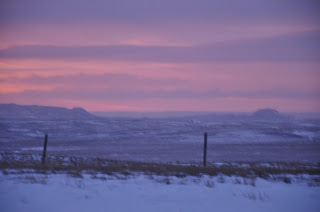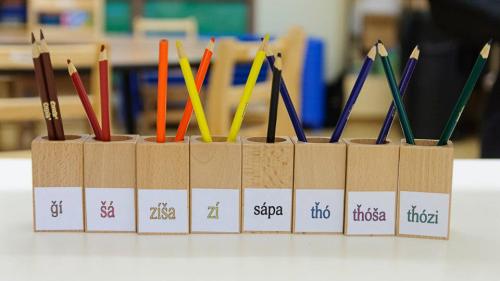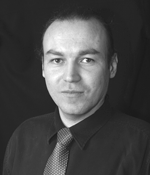Reviving A Language On The Knife’s Edge Of Extinction
By Dakota for the North Dakota Humanities Council
It is the heart of winter on the Standing Rock Sioux Indian
Reservation. Gleaming white snow blankets the landscape, the Missouri
River has turned to ice and the crisp cold air somehow makes every
sound sharper–the peal of a bell seems to carry an impossible distance from
town–but the sounds of children playing, laughing and singing warms everything.
The children are in pre-school, ages three to four. Their
high-pitched play echoes down the hall when their door opens. The pitch of
little voices sounds like what one would hear in any other early child care
service across the state, but listen closer and it becomes obvious that this
isn’t like any other day care service. The children speak a mix of English and
Lakota amongst themselves, but the teachers strictly speak only Lakota in the
classroom.
This preschool is called Lakȟól’iyapi
Wahóȟpi, the Lakota Language Nest. It is an immersion school still in its
first year of practice and based on the language nest model which was designed
by the Maori people in New Zeeland. The language nest was established to raise
language loss awareness on the reservation and to raise up a new generation of first-language
Lakota speakers.
The language nest is one part of the Lakota Language
Education Action Program (LLEAP) designed for students to go to college and
pursue language studies. Students who are in the program are given financial
aid to learn Lakota and gain proficiency in the language with the caveat that
LLEAP participants must teach the language. Many of the nest’s learners have
parents participating in LLEAP at Sitting
Bull College
Lakota language teacher, Tipiziwin Young engages a little boy, answering him only in Lakota.
Tipiziwin Young, a second-language teacher in the Lakȟól’iyapi Wahóȟpi program, estimates
that there are about 200 fluent Lakota speakers left on the Standing Rock Sioux
Indian Reservation. “A few years back, I was facetious with Jan Ullrich about
who I am and where I’m from when he said to me, ‘You’re language will die.’ He
didn’t say it to be mean. He said it to be real. I was moved to silence. I was
provoked. The loss of my language motivated me to learn it.” Young is an
enrolled member of the Standing Rock Sioux Tribe, born and raised on the
reservation, and a mother to three children. “I teach here, then go home and
stay in Lakota for my children to learn.”
A little boy with a mop of brown hair approaches me. In a
quiet unassuming voice he introduces himself to me. Thinking to obey the rule
of the classroom, I go down on one knee and respond, “Hau. Dakota émaĥčiyapi
lo.” I gesture to him, an open palm when I greet him, then gesture to my heart.
I place my right fist above my left fist over my heart, then gesture with my
right hand–index finger–to my mouth when I say my name. I’ve seen few others
use the Plains Indian sign and gesture language and the signs I made were for
“my” or “mine” and for “name.” I don’t know that his little one has seen the
old sign and gesture but he nods his head and smiles.
Sacheen Whitetail-Cross, Project Director of LLEAP and the Lakȟól’iyapi Wahóȟpi at Sitting Bull College Washington DC
One observation that Whitetail-Cross shared about the
children of the language nest is that they are showing ownership of Lakota. At
a recent program, they heard a Lakota speaker, and many of them told
Whitetail-Cross, “That’s my language.”
Tom Red Bird, the first-language teacher on staff at the Lakȟól’iyapi Wahóȟpi, approaches a group
of little boys near the window. One mischievous boy stands on a heater behind
the short bookcase which was put next to the window. “Héčé šni! [Don’t do
that!]” Red Bird says and gestures to the boy to get down. The boy casually
climbs down as though he were going to get down anyway and rejoins the other
boys.
Perhaps an indication of how comfortable the children are is
use of Lakota is in their own little conversations. Two of the children, a boy
and a girl are playing with Legos. They began to argue over a few choice bricks
in their construction. The boy wants a brick that the girl is already using. As
he reaches for it he says in English, “That’s mine!” She retorts in Lakota, “Šni!
Šni! Héčé šni! No, don’t do that!” and keeps her brick.
A father steps into the classroom. Chase Iron Eyes is his
name. His daughter Azilya is among the nest participants. “I heard of this
program through community members,” says Iron Eyes, “My wife and I were
immediately drawn to it. We wanted her to have this opportunity.” Iron Eyes
commutes each week day from Mandan ,
ND
Iron Eyes relates to me that Azilya experienced culture
shock for the first two weeks then she started to like it and began to speak
Lakota at home. Azilya’s older siblings have begun asking their sister and father
how to say things in Lakota, and she corrects her father’s Lakota grammar.
Chase Iron Eyes, Esq., founding contributing writer of The Last Real Indians has his mind going a hundred different directions, but his actions always serve the interests of the American Indian people. Profile photo of Chase Iron Eyes from The Last Real Indians.
Iron Eyes doesn’t believe that language revitalization today
equals a renaissance. “Its something that’s been building up now since the
1960s and ‘70s,” he points out, “native activists were and are proponents of
language practice. It’s not a renaissance because you live it.” Iron Eyes is
active with the community and engaged as a parent in the Lakȟól’iyapi Wahóȟpi program.
The children in the Lakȟól’iyapi
Wahóȟpi are getting to be good speakers. “Their American accent is going
away,” says Red Bird. They hold hands and pray before lunch. Little hands
clasped in little hands. When the prayer of thanksgiving, the Wota Wačéki, is finished the children
say together in unison, “Mitakuyé Oyasiŋ,”
the traditional way the Lakota conclude prayers meaning “All My Relatives.” During
lunch one of the little boys stops eating and spontaneously breaks into song,
singing in the Lakota language.
After the parents have picked up their children, Red Bird deeply
breathes what sounds like a sigh of satisfaction. The only relief he shares is
that the language is spoken again daily. “I like it,” Red Bird says in English,
“I get to speak my language all day. It feels good.” Red Bird is originally
from the Cheyenne River Sioux Indian Reservation, and had taught Lakota at United Tribes
Technical College
Red Bird has hopes for the children, the tĥakŏža, as he refers to them. “If this
keeps going, maybe in ten years we’ll have a new group of Lakota speakers who
speak the language correctly.” Red Bird is a great-grandfather and he speaks
only Lakota to his great-grandson. His optimism for what can only be called a
language revival pours out of him, “We have a culture and tradition, our
spirituality, a land base, and our relationship with all of those is best
expressed with words found only in our language. It is a sacred language.”
Whitetail-Cross’ hopes for language revival echoes Red Bird’s,
but her optimism is laced with concerns for the program, “Funding is an issue.”
The Lakȟól’iyapi Wahóȟpi program
received funding from an Administration of Native Americans grant for three
years. The first year of programming consisted of developing preschool
curriculum, training for language educators, and classroom startup. The Lakȟól’iyapi Wahóȟpi is in its second
year of funding, its first year of operation.
The North Dakota Humanities Council recently awarded a
$10,000 grant to the Lakȟól’iyapi Wahóȟpi
program to assist the program with publication of language materials, but
its not enough. Both Whitetail-Cross and Red Bird have expressed the dire need
for age-appropriate language materials. There isn’t much published.
Once a week, Red Bird will take a children’s book, translate
the text, and then read the story to the children. Having extra copies of Red
Bird’s translations for parents to take home and read with their children would
help to reinforce that day’s language lesson. “We desperately need more
language materials,” Red Bird said.
Jan Ullrich, linguistic director of the Lakota Language
Consortium, shares Red Bird’s concern for speaking the Lakota language
correctly. Ullrich has had a hand in the development of a standard Lakota
orthography for the New Lakota Dictionary. We converse on Skype getting to know
a little of one another before business. Ullrich is from the Czech Republic
Jan Ullrich may come from the Czech Republic but his heart is Lakota. Visit his work online at the Lakota Language Consortium.
Ullrich sends me the letters t, o, k and a. He then
asks me to pronounce what he’s spelled. I reply TOH-kah which can mean “enemy,” then follow up with toh-KAH which can mean “first.” Ullrich
then sends me the texts Tĥoka and Tĥoká. The accent marks take a moment to
get used to, but the new standard orthography he employs has me pronouncing
Lakota correctly when I read it.
Ullrich’s standard orthography isn’t embraced by all Lakota
speakers, nor is it the first effort at standard orthgraphy he admits. Sometime
back, a Lakota man named Curly from the Cheyenne River Sioux Indian Reservation
developed a thirty-six character alphabet. The main drawback with this alphabet
for modern Lakota speakers is that it involves learning and remembering
entirely new symbols. The new standard orthography makes use of the modern
keyboard and letters with sounds Lakota students learned with English, the only
addition are marks for accent, aspirants, glottal sounds and glottal stops.
Jan Ullrich is the editor of the New Lakota Dictionary, but being the editor means little to Ullrich who credits several Lakota people who've contributed to this work. Support the Lakota Language Consortium and buy a copy of this dictionary or any other of their published Lakota language materials online at the Lakota Language Consortium Bookstore.
“Missionaries did a good job of starting the process of
recording the language,” explains Ullrich, “But they ‘invented’ new words in
the interest of literal word for word translation, rather than translation of
concept for concept.” Thousands of entries in the Buechel and Riggs
dictionaries should be carefully and critically examined according to Ullrich. These
dictionaries should also be praised for bringing the Lakota and Dakota
languages to the general public’s attention.
Ullrich recently joined the Lakȟól’iyapi Wahóȟpi via Skype to encourage the young learners and
to offer courage to the language teachers. Like Red Bird, Ullrich believes that
the key to language revitalizing is learning consistently and accurately.
Young gathers the children together in a circle on a soft
blue carpet. A couple of the children take their time in getting to the circle.
Young raises her voice a little, “Inaĥni!” she says, hurry. I know the word well from my own childhood and it becomes
obvious that these young ones do too. “Iyotake, iyotake,” Young commands with
the strong confidence that mother’s everywhere instinctively possess. Sit down, sit down, and they do so
without argument.
She takes out a pen and paper and quickly draws a series of
faces with a variety of expressions. The children respond somewhat in unison,
“Iyokipiya!” “Wačiŋko!” Happy! Sad!
The children tell her in Lakota what faces to draw next and she obliges. When
they finish this exercise, they even take time to sing happy birthday to two of
the boys, “Aŋpétu tuŋpi,” Young begins and the tĥakŏža sing following her cues. It is to the popular tune “Good
morning to all” which was popularly appropriated to the Happy Birthday song,
and it’s a close translation in Lakota, They
day you were born.
Little voices singing in Lakota continue to echo in my mind
when I leave the Lakȟól’iyapi Wahóȟpi,
the Lakota Language Nest. It was spoken everyday in the days of warriors and
legend. It was spoken everyday when the reservations were established.
The Bismarck Indian Boarding School for girls, 1933.
Somehow along the way between then and now the language
began to die through a variety of reasons. Some speakers were scarred from
their experiences in learning English during the boarding school days. Some
left the reservation and never returned, their children and grandchildren grew
up speaking only English. Schools on the reservation teach only in English.
Lakota became a language for church or special occasion.
These tĥakŏža speak
the language in fun, in play, in prayer, and even in arguments. They can
express themselves and articulate their feelings accurately through the
knowledge of two languages. Perhaps English has too many words. There is a word
for everything, a noun. It’s a language of things. Lakota is a language of
description and relation, and that’s just what we need these days.
Support the Lakȟól’iyapi Wahóȟpi, the Lakota Language Nest. Contact Sacheen Whitetail-Cross at Sitting Bull College at (701) 854-8034 or sacheenw@sbci.edu about what you can do to save the language.
Support the Lakota Language Consortium. Visit them online at www.lakhota.org.
Or make a donation to the North Dakota Humanities Council. The NDHC will make sure that the Lakota Language Nest receives your support. Contact the NDHC at (701) 255-3360, or council@ndhumanities.org.















Hi, what a great web blog. childcare hills area
ReplyDeleteSo true On Childcare Hills Area, and what’s perhaps even more devastating is that there’s been so little support to help the community rebuild.
ReplyDeleteTo jumpstart a career in medical transcription, a degree or diploma in the field is required. A formal training in any medical course is sufficient to land anyone a position in this industry. http://techniciansalary.net/medical-transcriptionist-salary-in-north-dakota/. Click here
ReplyDeletegreat article good to know this thanks for this article.Toddler School
ReplyDelete